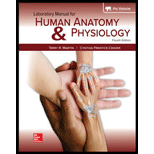
Concept explainers
Chest and shoulder muscles that move the arm at the shoulder joint have insertions on the
a. scapula.
b. clavicle and ribs.
c. humerus
d. radius or ulna.
Introduction:
A joint is a connection between the bones in the body. The function of the joints is to allow various degrees and types of movements in the body. There are certain frictionless joints, such as knee, elbow, and shoulder. These joints can withstand compression and heavy weights easily.
Answer to Problem 1PL
Correct answer:
Option (c), humerus.
Explanation of Solution
Explanation/justification for the correct answer:
Option (c) humerus. Chest and shoulder muscles make the arm movement at the shoulder joint. These two muscles have insertion at the humerus. Hence, this option is correct.
Explanation for incorrect answer:
Option (a) scapula. The scapula is the insertion for the levator scapulae muscle. The scapula is present on both the sides of the upper back and just behind the shoulders. Hence, this option is incorrect.
Option (b) clavicle and ribs. The subclavius muscle has insertion at the clavicle and the rib cage. Hence, this option is incorrect.
Option (d) radius or ulna. The biceps have an origin at the shoulder joint and insertion at the radius, near the elbow joint. Hence, this option is incorrect.
Want to see more full solutions like this?
Chapter 23 Solutions
Laboratory Manual For Human Anatomy & Physiology
- when a person is in respiratory distress the origin and insertion of the serratus anterior muscle may actually switch and the part of the muscle attached to the medial border of the scapula acts as the origin, how will the change the muscle 's action?arrow_forwardThe function of the biceps femoris is to A. flex the hip and ankle. B. extend the thigh and flex the leg. C. flex the thigh and extend the leg. D. flex the thigh (with no action at the leg). E. adduct the thigh and extend the knee.arrow_forward(a) Name two forearm muscles that are both powerful extensors and abductors of the hand at the wrist. (b) Name the only forearm muscle that can flex the distal interphalangeal joints. (c) Name the hand muscles responsible for opposition.arrow_forward
- What muscles are responsible for the ribcage to lift upwards?arrow_forwardWhich of the following muscle does not laterally rotate the thigh. a) obturatorius internus muscle b) gemellus inferior muscle C) Priformis muscle D) gluteus minimus muscle F) gemellus superior musclearrow_forwardWhen the left and right ________ contract, they flex the head and neck. a. sternocleidomastoid b. longissimus group c. splenius d. rectus abdominisarrow_forward
 Fundamentals of Sectional Anatomy: An Imaging App...BiologyISBN:9781133960867Author:Denise L. LazoPublisher:Cengage Learning
Fundamentals of Sectional Anatomy: An Imaging App...BiologyISBN:9781133960867Author:Denise L. LazoPublisher:Cengage Learning


